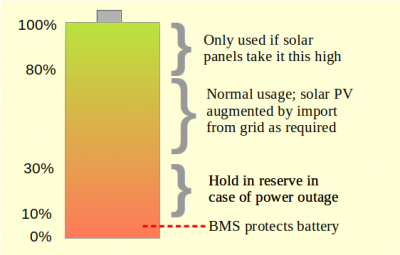Battery...Full house back up
One detail that you may want to consider is the warranty on the battery. I recall that the warranty (minimum 70% storage capacity aftre 10 years) for the Powerwall 2 was conditional on the the total energy throughput which worked out to be one full charge / discharge cycle per day. However, if your anticipated 2.5 charge/discharge cycles per day is the worst case then this may average out to nearer unity over a year.
Well I'm pleased to see you doing the background research first @broadsman !
I can assist with the technical issues, but none of us can adequately predict the future tariffs on which you are building your viability assessment.
I have a fair idea of how future tariffs should work over the next 5-years as the electricity grid is decarbonised.
But both DESNZ and Ofgem have been demonstrating a propensity to manipulate the electricity supply system by 'regulations' rather than the laws of physics.
Yes, there will still be frequent cheap-rate periods, but they will be less regular.
The overnight cheap-rate can't survive because it's based on Combined Cycle Gas Turbine (CCGT) generation, for example.
Turning briefly to the matter of a Tesla PowerWall-3:
These Powerwalls vary considerably from the 1st generation which used the same LiMNC chemistry as Tesla cars.
The Lithium Ferrous Phosphate (LiFePO4) chemistry is inherently more stable and can be recharged more often for a given 'loss of capacity'.
However, it's very difficult to assess this because each LiFePO4 cell manufacturer uses a different standard.
Typically they will state something like "10,000 charge/discharge cycles over its lifetime".
But the 'lifetime' might be to 70% of the original stated capacity (in Amp-hours)
or 80% of the actual capacity when first supplied.
These are two different concepts.
All cell manufacturers sell products with a higher actual capacity than that which is advertised.
A cell labelled 280Ah, might actually have 298Ah.
The 280Ah refers to the minimum capacity, in order to satisfy its A-grade rating and trading standards legislation.
Equally, households with battery storage aren't very likely to put those cells through complete charge/discharge cycles.
Most of the time we'll be using only the central portion of the available capacity, whilst leaving enough in reserve to ride-out a power-cut.
So our cells won't 'age' as fast.
Have you seen the YouTube clip in this post about the new battery/inverter products to be released by Givenergy this year?
It's not the approach which I'm taking, but it's certainly one which might appeal to you.
Save energy... recycle electrons!
- 26 Forums
- 2,342 Topics
- 53 K Posts
- 432 Online
- 6,000 Members
Join Us!
Worth Watching
Latest Posts
-

RE: Setback savings - fact or fiction?
@robs — thanks again for your detailed comments. Some r...
By cathodeRay , 32 minutes ago
-
RE: Configuring third party dongle for Ecodan local control
Appreciate the great write up @majordennisbloodnok and ...
By F1p , 1 hour ago
-
RE: Are We Sleepwalking Into Another Race to the Bottom?
The thing that worries me is that this brainless crap i...
By JamesPa , 2 hours ago
-
RE: Free Ecoheat Heat Pump Install
I don't mind thread drift, it's how conversation natura...
By Deltona , 2 hours ago
-

RE: A Smarter Smart Controller from Homely?
@papahuhu I hope you get a swift resolution. Regards, T...
By Toodles , 4 hours ago
-

RE: Poll for Time of Use, tariffs, technology
That’s fine by me too Major, I feel it is a sad reflect...
By Toodles , 6 hours ago
-

Bingo. Sometimes a judiciously placed size 10 bovver bo...
By Majordennisbloodnok , 6 hours ago
-
RE: Mitsubishi Ecodan 11.2kW heat pump with low COP
@ciocoiu-alexandru I can't provide the same level of di...
By Sheriff Fatman , 6 hours ago
-
RE: Octopus Cosy Heat Pump Owners & Discussion Thread
Recently had my follow up with octopus for the vibratio...
By swwils , 8 hours ago
-

The three technical issues I'm considering are: BMS...
By Transparent , 9 hours ago
-
RE: LiFePO4 lithium battery fires and explosions
@transparent Your post may fit better in th...
By Batpred , 9 hours ago
-

RE: British Gas vs Octopus Energy vs Heat Geek vs EDF vs Aira vs OVO vs EON.Next vs Boxt
@jamespawhite, if you could be bothered, you could also...
By Mars , 11 hours ago
-
RE: Commencing on an ASHP Installation Process
I've got a bit of time to draft something today, so the...
By Sheriff Fatman , 1 day ago
-
RE: Help with heat pump sizing
@amin I dont think materially relative to t...
By JamesPa , 1 day ago
-

@majordennisbloodnok I have decided to take the plunge....
By TechnoGeek , 1 day ago
-
RE: Different dT on each radiator?
I cant sorry. Its based on some calculations I did fro...
By JamesPa , 2 days ago
-
RE: Help me keep the faith with my air source heat pump installation
@simonf thats interesting as I’ve noticed my flow and r...
By AdamK , 2 days ago
-

RE: MELcloud scheduling misbehaviour
No, it gets to set temperature easily even during perio...
By Abernyte , 2 days ago




